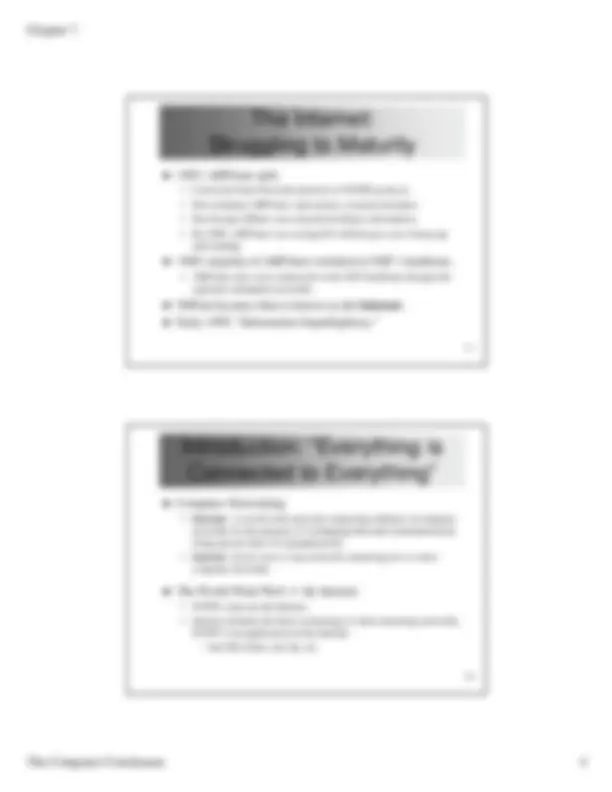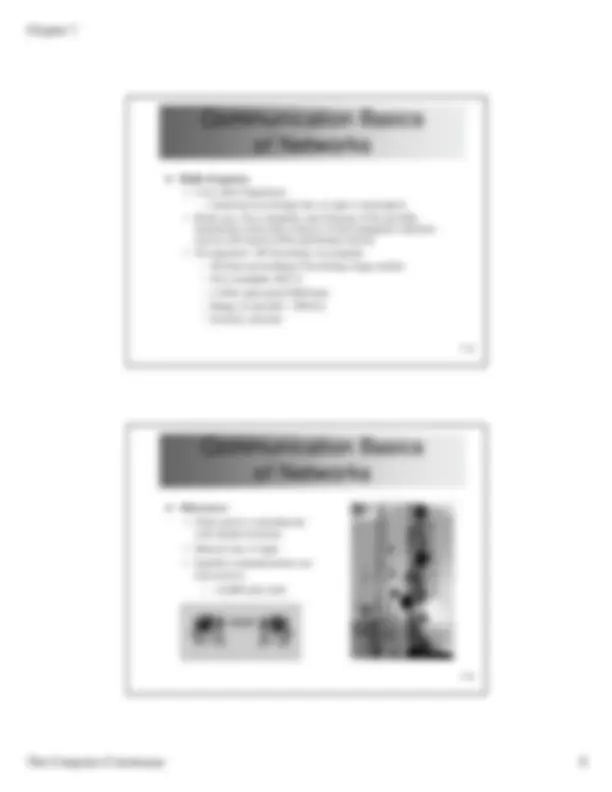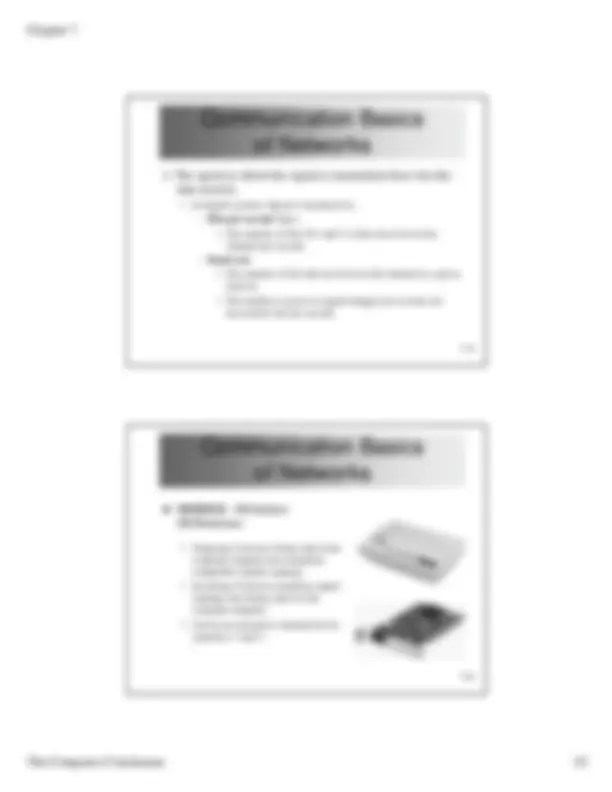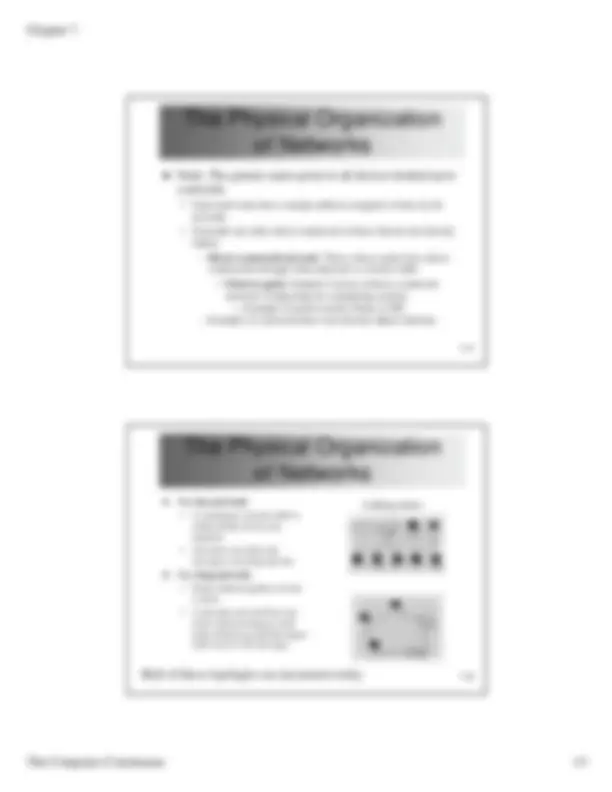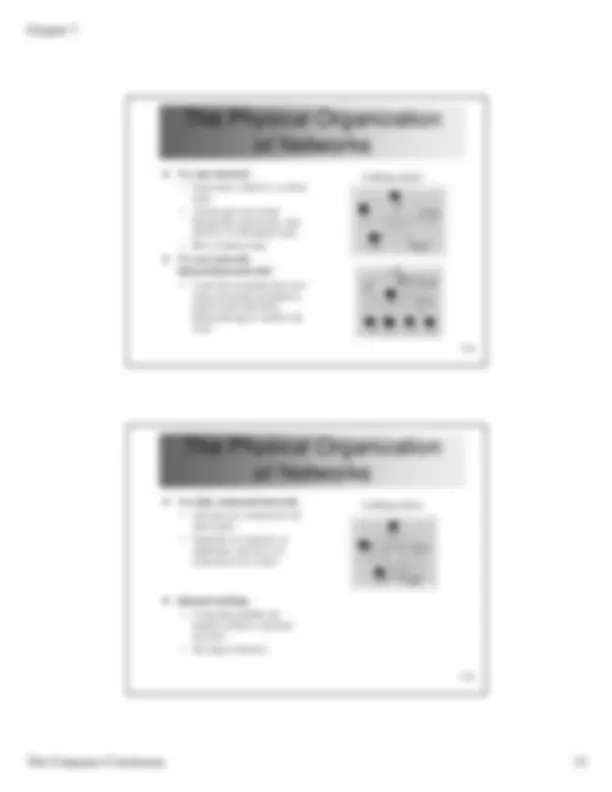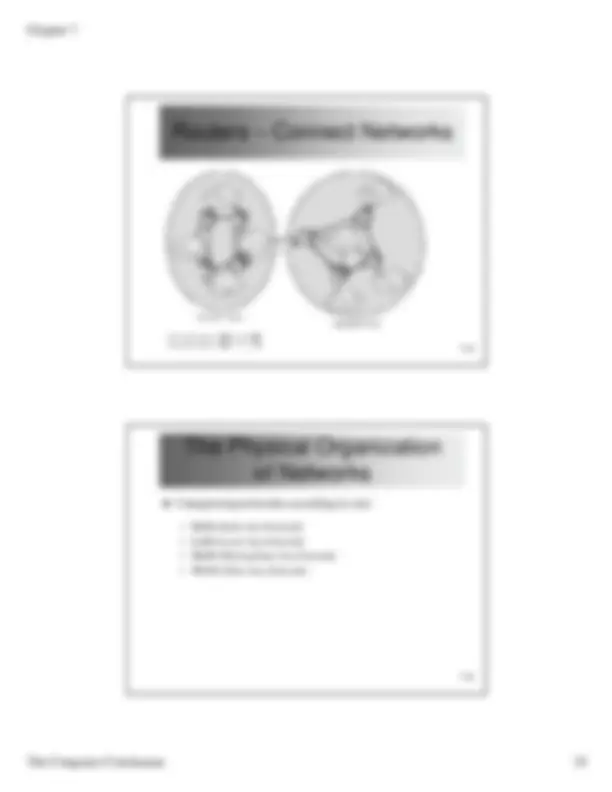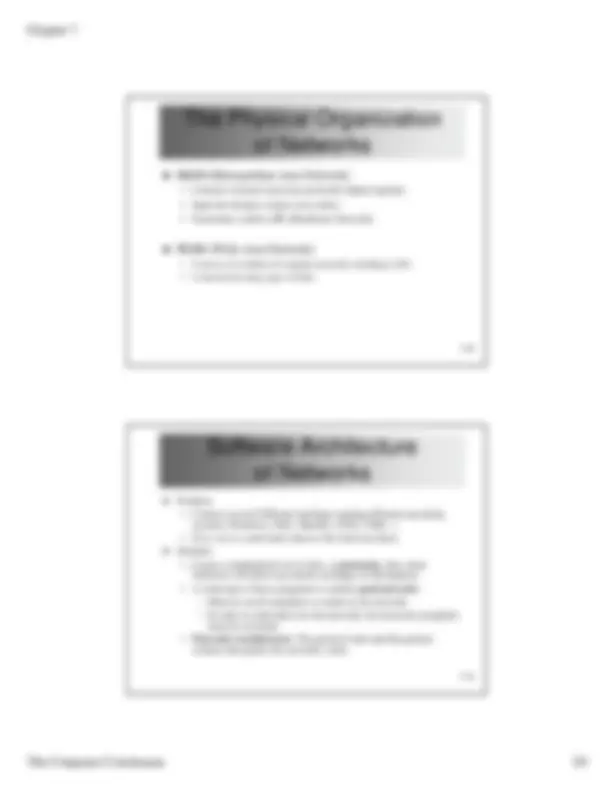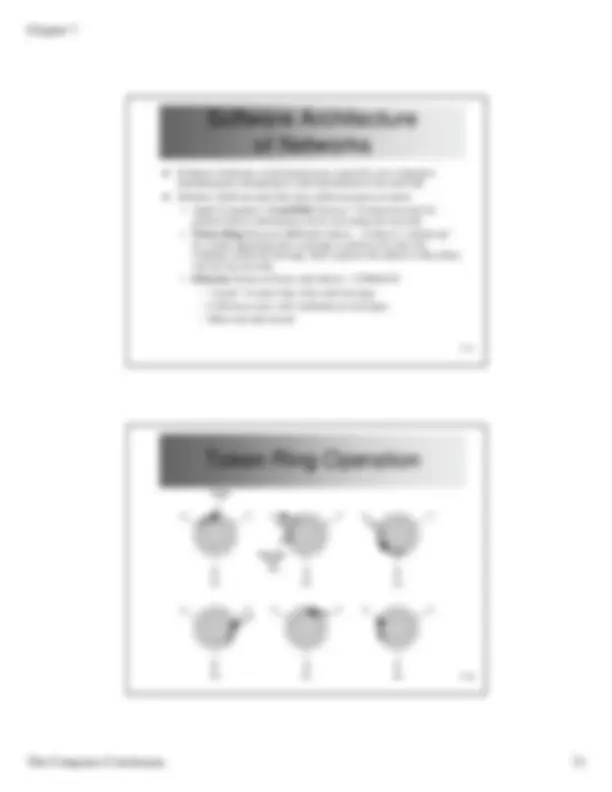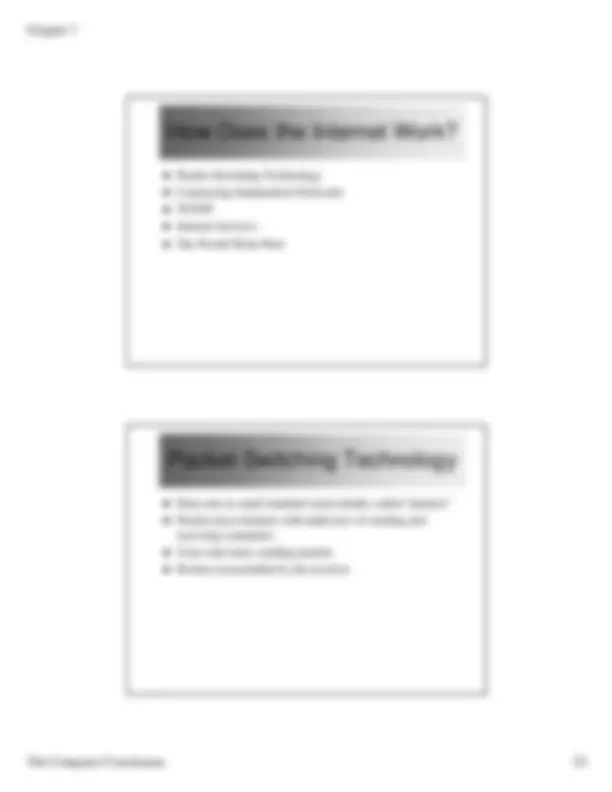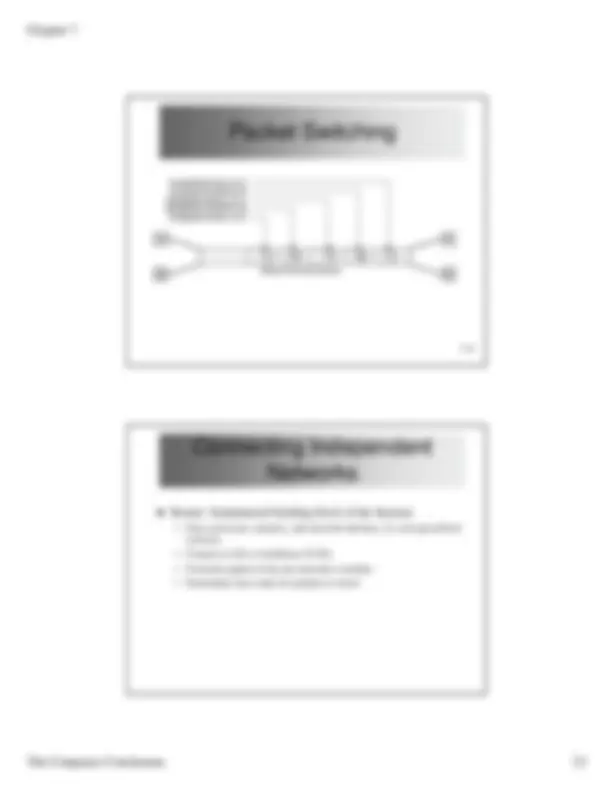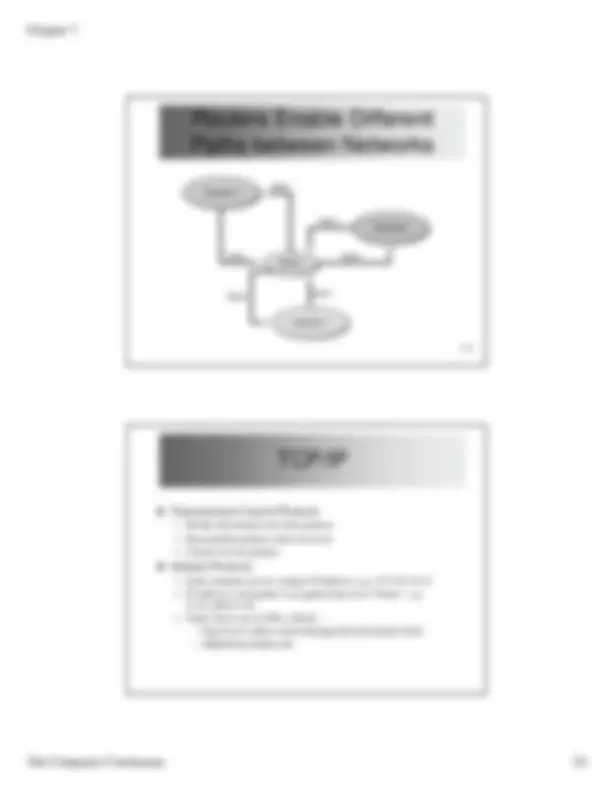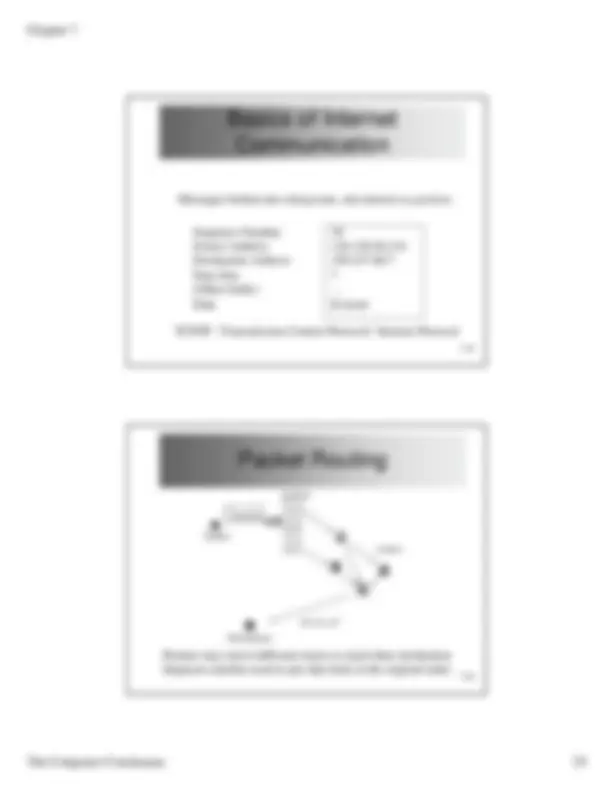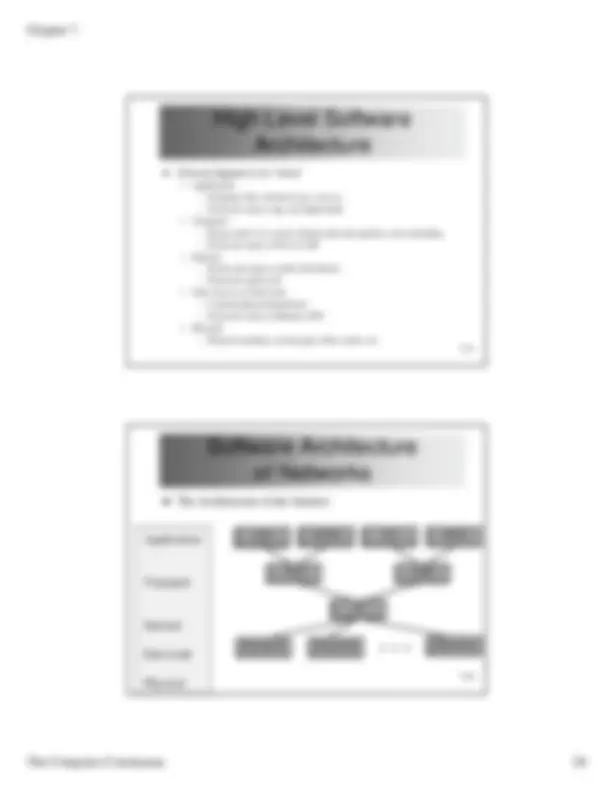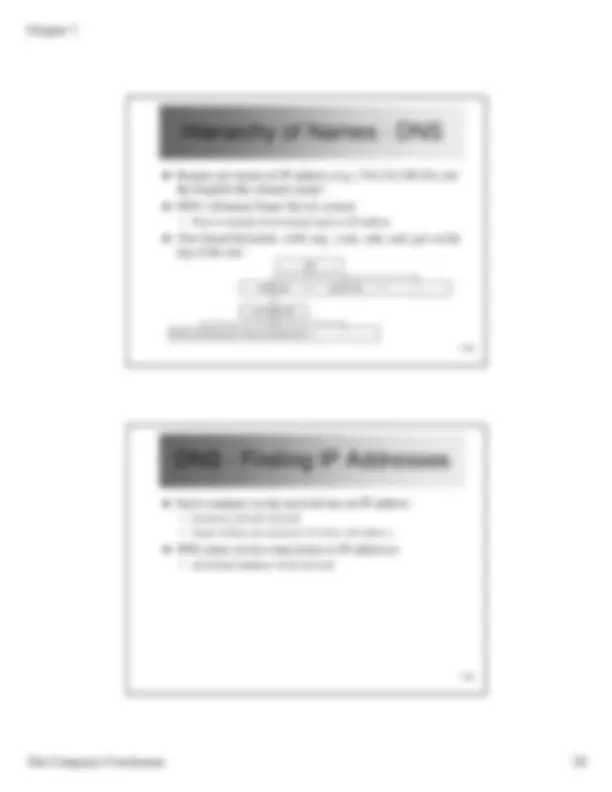Download Network Concepts and Communications - Lecture Slides | CS A101 and more Study notes Computer Science in PDF only on Docsity!
7-
Chapter 7:
Network Concepts and
Communications
Going online to do everything from banking to
buying groceries, just a fad or is it here to stay?
7-
Network Concepts
and Communication
! In this lecture:
- What can be done online?
- How are computers connected?
- What are the physical properties of networks?
- How does a computer communicate with a network?
- Can all computers talk to each other?
- How does TCP/IP work?
7-
Introduction: “Everything is
Connected to Everything”
! Going online: Connecting to a collection of interconnected
computers on a network.
- Do banking.
- Pay bills.
- Buy groceries.
- Book vacation travel.
- Send messages.
- Participate in discussions.
- Do research.
- Play games.
! Network : A collection of computers, display terminals, printers, and other devices linked either by physical or wireless means.
7-
Introduction: “Everything is
Connected to Everything”
! Seeds of Networking
- 1966: ARPA (Advanced Research Projects Agency) State Defense Department’s research organization. - Focused major development effort on computer networking. - ARPA’s Goal: To promote research in advanced future technologies by funding university and industry research proposals. - Distributed communication system - Enable research communication - Enable dissimilar computers to share information - Reroute information automatically - Act as a network of networks; internetworking
- Result: Thousands of databases became available to the public.
7-
The Internet:
Struggling to Maturity
! 1983: ARPAnet split.
- Converted from Network protocol to TCP/IP protocol.
- Part remained ARPAnet: universities, research institutes.
- Part became Milnet: non-classified military information.
- By 1989, ARPAnet was costing $14 million per year to keep up and running.
! 1989: majority of ARPAnet switched to NSF’s backbone.
- ARPAnet sites were connected to the NSF backbone through the regional community networks.
! NSFnet became what is known as the Internet.
! Early 1995: “Information Superhighway.”
7-
Introduction: “Everything is
Connected to Everything”
! Computer Networking
- Internet : A world-wide network connecting millions of computer networks for the purpose of exchanging data and communications using special rules of communication.
- internet : (lower case i) Any network connecting two or more computer networks.
! The World Wide Web <> the Internet
- WWW exists on the Internet
- Internet includes the basic technology of interconnecting networks, WWW is an application on the Internet - Just like telnet, ssh, ftp, etc.
7-
Communication Basics
of Networks
! Types of connections of computers into networks: Physical
versus Wireless connections
- The first type: The Physical Connection.
- Physically connect computers together.
- Use of wires or optical cables.
- The connections are called network links.
- Three most common physical links:
- Twisted pair
- Coaxial cable
- Fiber-optic cable
7-
Communication Basics
of Networks
! Twisted pair
- Two wires twisted together.
- Makes them less susceptible to acting like an antenna and picking up radio frequency information or appliance noise.
- Cat1 to Cat5e
- Shielded, Unshielded, use RJ-45 connector
- 10BaseT or 100BaseT network
- Telephone company uses twisted-pair copper wires to link telephones.
7-
Communication Basics
of Networks
! Second type of connections of computers into networks:
Wireless connections
- The link is made using electromagnetic energy that goes through space instead of along wires or cables.
- Three types of wireless communications commonly used in networking: - Infrared - Radio frequency - Microwave
7-
Communication Basics
of Networks
! Infrared
- Commonly used in TV and VCR remote controls.
- Use infrared frequencies of electromagnetic radiation that behave much like visible light.
- Must be in the line of sight.
- Often used to connect keyboards, mice, and printers.
- Relatively slow due to protocol
7-
Communication Basics
of Networks
! Radio frequency
- Uses radio frequencies.
- Function even though line of sight is interrupted.
- Book says: Not commonly used because of the possible interference from other sources of electromagnetic radiation such as old electric drills and furnace motors.
- Not anymore! RF becoming very popular
- Wireless networking is becoming a huge market
- New standards, 802.
- 2.4Ghz unlicensed ISM band
- Range of typically ~300 feet
- Security concerns
7-
Communication Basics
of Networks
! Microwave
- Often used to communicate with distant locations.
- Must be line of sight.
- Satellite communications use microwaves. - ~22,000 mile orbit
7-
Communication Basics
of Networks
2. The speed at which the signal is transmitted (how fast the
data travels).
- In digital systems: Speed is measured in...
- Bits per second (bps).
- The number of bits (0’s and 1’s) that travel down the channel per second.
- Baud rate
- The number of bits that travel down the channel in a given interval.
- The number is given in signal changes per second, not necessarily bits per second.
7-
Communication Basics
of Networks
! MODEM - MOdulator
DEModulator
- Outgoing: Converts binary data from computer (digital) into telephone compatible signals (analog).
- Incoming: Converts telephone signal (analog) into binary data for the computer (digital).
- Can be an external or internal device (usually a “card”).
7-
Communication Basics
of Networks
! Speed of Signal: Sample bps and baud rate speeds.
300 bps (=300 baud) Painfully slow to the college-level reader 1200 bps (=1200 baud) Good reader can keep up 2400 bps (=2400 baud) A speed reader would get the general idea 9600 bps (=9600 baud) Impossible to read 14.4 K bps (not measured in baud) 14,400 bps - 10 to 20 sec. wait for graphics 28.8 K bps Minimum desired for WWW (5 to 10 sec. wait for graphics) 56 K bps Efficient speed for WWW.
These speeds are restricted to the maximum speed of the modem at the other end of the connection.
7-
Communication Basics
of Networks
3. The type of data movement allowed on the channel.
- Simplex transmission - One way transmission.
- Half-duplex transmission - Flows only one way at a time.
- Full-duplex transmission - Two-way transmission at the same time.
7-
Communication Basics
of Networks
! How is it possible to measure the capacity of
communications links?
- Bandwidth : Digital
- Number of bits per second (bps) that can be sent over a link.
- The wider the bandwidth, the more diverse kinds of information can be sent.
- Simplest is voice, most sophisticated is moving videos.
- Bandwidth : Analog
- The difference between the highest and lowest frequencies that can be sent over an analog link (like phone lines).
- Measurement is given in cycles per second, or hertz (Hz).
- For both : The wider the bandwidth, the more information can flow over the channel.
7-
Communication Basics
of Networks
Mbps = megabytes per sec. (millions) Gbps=Gigabytes per sec. (billions)
Typical cable bandwidths used in local area networks. Cable: Typical Bandwidth: Twisted Pair 10 to 100 Mbps Coaxial Cable 10 to 100 Mbps Fiber-optic cable 100 to 200 Mbps
The bandwidths of different services offered by a telephone company: Service: Bandwidth ISDN 64 Kbps/channel T1 1.544 Mbps T3 44.736 Mbps STS-1 51.840 Mbps STS-3 155.250 Mbps STS-12 622.080 Mbps STS-24 1.244160 Gbps STS-48 2.488320 Gbps
7-
The Physical Organization
of Networks
! Node: The generic name given to all devices hooked up to
a network.
- Each node must have a unique address assigned to them by the network.
- Networks are either direct-connected or those that are not directly linked. - Direct-connected network : Those whose nodes have direct connections through either physical or wireless links. - Point-to-point : Simplest version of direct-connected network. Connecting two computing systems. » Example of point to point: Home to ISP. - Example of a network that is not directly linked: Internet.
7-
The Physical Organization
of Networks
! The bus network -
- A continuous coaxial cable to which all the devices are attached.
- All nodes can detect all messages sent along the bus. ! The ring network -
- Nodes linked together to form a circle.
- A message sent out from one node is passed along to each node in between until the target node receives the message.
Linking nodes:
Both of these topologies are uncommon today
7-
Hardware Architecture
of Networks
! Types of hardware used to create networks:
Hub A device that repeats or broadcasts the network stream of information to individual nodes ( usually personal computers) Switch A device that receives packets from its input link, and then sorts them and transmits them over the proper link that connects to the node addressed. Bridge Transparently links two local networks that have identical rules of communication. Gateway A link between two different networks that have different rules of communication. Router A node that sends network packets in one of many possible directions to get them to their destination.
7-
Star Network via Hub
Workstation
Hub
7-
Bridge LAN / Backbone Design
7-
Switched LAN / Backbone Design
7-
The Physical Organization
of Networks
! DAN (Desk Area Network)
- Making all components of a desktop computer available to other computers on the network. - CPU - Unused computing power can be used by other computers on the network. - Hard Disk - Items stored can be accessed by others or items may be placed on the hard drive from other computers. - Video Display - Alert messages can be sent to the computer’s display. - Other items - Other devices connected to the computer might be needed by others connected to the network.
7-
The Physical Organization
of Networks
! LAN (Local Area Network)
- A collection of nodes within a small area.
- The nodes are linked in a bus, ring, star, tree, or fully connected topology network configuration.
- Benefits of LANs:
- Sharing of hardware resources.
- Sharing of software and data.
- Consolidated wiring/cabling.
- Simultaneous distribution of information.
- More efficient person-to-person communication.
7-
The Physical Organization
of Networks
! MAN (Metropolitan Area Network)
- Consists of many local area networks linked together.
- Span the distance of just a few miles.
- Sometimes called a BN (Backbone Network)
! WAN (Wide Area Network)
- Consists of a number of computer networks including LANs.
- Connected by many types of links.
7-
Software Architecture
of Networks
! Problem:
- Connect several different machines running different operating systems (Windows, OS/2, MacOS, UNIX, VMS...)
- Now, try to: send email, data or files between them. ! Solution:
- Create a standardized set of rules, or protocols , that, when followed, will allow an orderly exchange of information.
- A collection of these programs is called a protocol suite.
- Must be on all computers or nodes in the network.
- In order to send data over the network, the necessary programs must be executed.
- Network’s architecture : The protocol suite and the general scheme that guides the network’s rules.


